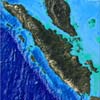| . |  |
. |
Barcelona, Spain (SPX) Jul 11, 2005 Alvaro Corral, a physicist at the Universitat Autonoma de Barcelona, has discovered that the structure of the recurrence time of earthquakes, which is the time interval between successive earthquakes, is similar to the spatial structure of physics systems when they change phase in the "critical points". The research has been and shows that the time interval between successive earthquakes depends on the time that elapsed between previous earthquakes. Although this is dependent upon statistics, the discovery may help to improve risk estimation. Examples of critical phenomena in nature include when water changes state, moving from liquid to gaseous form, and when a magnet is at the critical point, where it loses its magnetism because of the high temperature. I n the second example the magnet has a property that exists only at the moment when it changes state. This property is called self-similarity at different scales. When the temperature is below the critical point, the microscopic magnets that form the magnetic fields are well ordered and point mainly all in the same direction. When the temperature rises above the critical point, everything becomes chaotic, each microscopic magnet points in a random direction, and there is no global magnetic field. When the temperature is at the critical point, on the borderline, the microscopic magnets that point in the same direction are grouped together in small clusters. If we step back and look at a larger area, we see that these clusters are grouped also in clusters of clusters, and the same thing occurs each time we look at a larger area. This is what is meant by self-similarity at different scales. The discovery made by the UAB researcher is that this self-similarity at different scales also occurs in the time intervals between earthquakes. This means that if we note the different earthquakes that have taken place in a given zone over a large period of time, we see that they are grouped together, but the most surprising thing is that if we look at a longer period of time, the groups of earthquakes are themselves also grouped in larger clusters. And the same happens for any period of time, for earthquakes of any magnitude, wherever they take place in the world. This has a fundamental implication on the type of phenomenon that earthquakes are. Rather than being chaotic, as one might think, we can consider them to be critical. As Corral confirmed, "for this self-similar structure to exist, the role of correlations between earthquakes must be very important, that is, the interval between earthquakes must be dependant on previous earthquakes in a very determined way." Dr. Corral clarified by saying "This does not mean that this dependence is determinist; it does not allow us to predict when the next earthquake will occur, but there is a clear statistical dependence that may help to improve risk estimation." Related Links Universitat Autonoma de Barcelona SpaceDaily Search SpaceDaily Subscribe To SpaceDaily Express  Jakarta (AFP) Jul 05, 2005
Jakarta (AFP) Jul 05, 2005An earthquake measuring 6.0 on the Richter scale rocked Indonesia's Sumatra island on Tuesday, causing panic but there were no reports of casualties or damage, meteorologists said. |
|
| The content herein, unless otherwise known to be public domain, are Copyright 1995-2006 - SpaceDaily.AFP and UPI Wire Stories are copyright Agence France-Presse and United Press International. ESA PortalReports are copyright European Space Agency. All NASA sourced material is public domain. Additionalcopyrights may apply in whole or part to other bona fide parties. Advertising does not imply endorsement,agreement or approval of any opinions, statements or information provided by SpaceDaily on any Web page published or hosted by SpaceDaily. Privacy Statement |